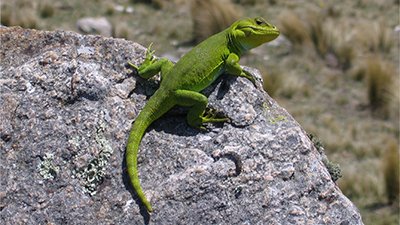Chameleon Fun Facts
Learn fun facts about chameleons.
- Besides changing colors and patterns, chameleons also “talk” to each other by flattening themselves sideways to look taller, rocking from side to side, curling and uncurling their tails and opening their mouths.
- A chameleon’s tongue launches at more than 26 body lengths per second. It accelerates from 0 to 20 feet per second in 20 milliseconds.1 At 50 g (50 times the acceleration due to gravity), the acceleration is 5 times the acceleration of a fighter jet.
- Some chameleons eat leaves in addition to the standard insect fare. Occasionally, they will launch their tongues at distant leaves and even water droplets. Perhaps in a pre-Fall world, before Adam sinned, chameleons used their tongues in the same fashion but ate only leaves. God foreknew the Fall, and His design of the chameleon’s tongue would prove to be a great asset in the post-Fall world.
- Chameleons can sharply focus on an object as little as one inch away.
- Chameleons are usually very solitary. But sometimes you will see a pair of them together or one male with several females.
- Some chameleons will dig pits or tunnels to lay two to as many as eighty eggs, depending on the species. Incubation can be as little as a month and a half to as long as two years. Eggs within a clutch usually hatch within days of each other. The offspring sometimes dig together to the surface, after which they are on their own.
- The babies of some species, especially those from mountainous environments, develop completely inside the mother’s body. Shortly after birth, they break free of the clear membrane encasing them.
- Males most often have more elaborate ornamentations (such as the presence of or a greater number of horns) and are more brightly colored than females. In some species, however, females are extremely colorful, much more so than the males.
- Most chameleons are found in sub-Saharan Africa as well as on the island country of Madagascar. Some are also found in northern Africa, southern Europe, southern India, the Middle East, Sri Lanka, and several smaller islands in the western Indian Ocean. They live in varied habitats, from rainforests to savannas and even deserts.
Footnotes
- Bijal P. Trivedi, “‘Catapults’ Give Chameleon Tongues Superspeed, Study Says” in National Geographic News, http://news.nationalgeographic.com/news/2004/05/0519_040519_tvchameleons.html.
Recommended Resources
Support the creation/gospel message by donating or getting involved!

Answers in Genesis is an apologetics ministry, dedicated to helping Christians defend their faith and proclaim the good news of Jesus Christ.
- Customer Service 800.778.3390
- Available Monday–Friday | 9 AM–5 PM ET
- © 2025 Answers in Genesis





